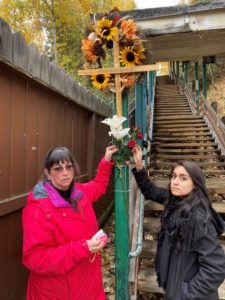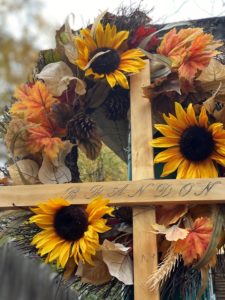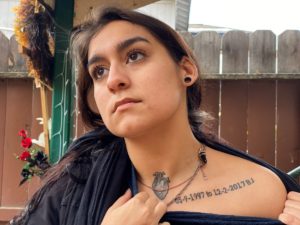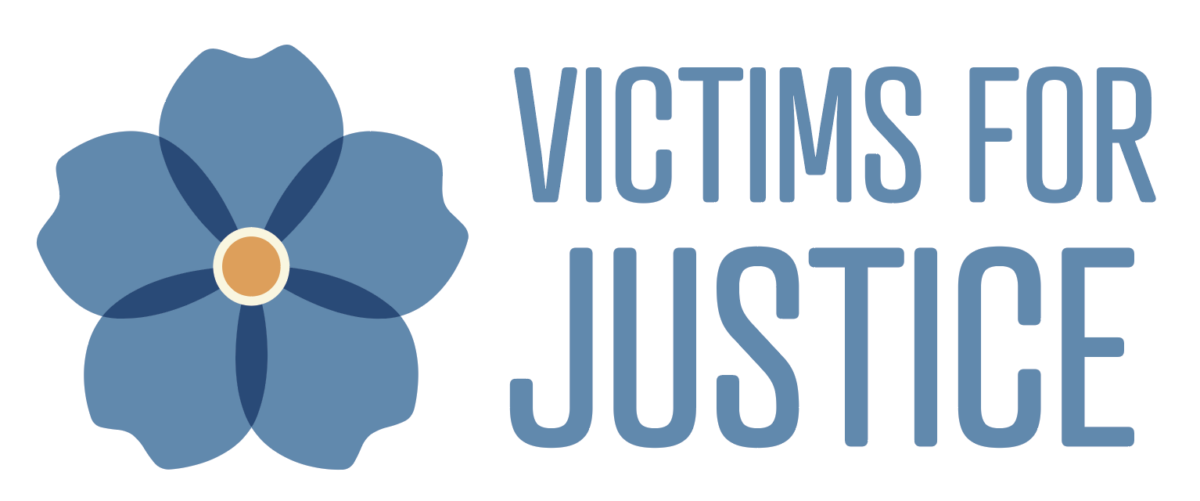Grandmother seeks justice in Anchorage cold case

Nancy Furlow and her granddaughter Kaitlin Duplisea visit the memorial dedicated to Brandon Irlmeier who was murdered on December 2, 2017.
On a rainy fall afternoon in northeast Anchorage, a Sitka grandmother stood grieving before a homemade memorial: a wooden cross encircled by a wreath of sunflowers and autumn features.
The memorial adorns the base of a covered staircase that spills into a cul-de-sac on East 6th Avenue. Creekside Park Elementary, its playground and young students sit across the street. It’s on these stairs that her grandson’s life ended in a violent homicide.
Nancy Furlow gently touched the wreath with her hand on this cold autumn day.
“I don’t want Brandon to be forgotten,” said Furlow, whose Tlingit name is Sutxwaan.
In town for a medical appointment, Furlow comes to this spot as often as she can to remember the 20-year-old man she raised since infancy.
Old Man Raven

A photo of Brandon Irlmeier that accompanies his obituary.
His name was Brandon Christopher Irlmeier. In Tlingit, his name was Yeil Yugóo (Old Man Raven). Irlmeier was beaten, strangled, shot, and left to die in freezing rain at the bottom of the staircase. The murder took place four years ago, on December 2, 2017.
Police have made no arrests.
With the fourth anniversary of the homicide approaching, Furlow wants to know why her grandson’s case has gone grown cold. Police at the time said they were looking for three persons of interest in connection with Irlmeier’s murder. One man, Orion Lind, was taken in for questioning but was not arrested. So far, nothing seems to have come of the investigation.
“I call the homicide detective every few months. He said the case is still open but that he has nothing new to report,” Furlow said. “Brandon deserves justice.”
Endless nightmare
Irlmeier’s case is still an open investigation, according to Anchorage police. Because of that, the department won’t say where the case currently stands or if there’s been any progress in finding Irlmeier’s killers.
“We have nothing to add at this time,” police spokeswoman Renee Oistad told Victims for Justice in November.
Victims for Justice has assisted Furlow since her grandson’s murder and holds monthly grief groups she attends by Zoom.
Besides her sorrow, Furlow wrestles with anger at the injustice of her grandson’s murder and the fact that his killers are free. What she calls her “endless nightmare” is compounded every time Irlmeier’s memorial gets vandalized. It’s been torn down repeatedly, burned, and a bullet has been left among the yellow plastic leaves.

A close-up of Brandon Irlmeier’s memorial.
“I’m certain the people who killed Brandon are behind the vandalism,” she said.
Furlow would like security cameras installed on the walkway to help catch the vandals.
Nothing will bring her grandson back but knowing who is destroying his memorial might shed light on the murder case, she said.
Stealing hearts
Irlmeier was born in Santa Barbara, Calif., as Furlow studied for her doctorate in Native American religious traditions. He was a happy baby and grew into a young man who loved music, the outdoors, and had a strong sense of humor.
“Brandon stole the heart of anyone and everyone around him,” Furlow said.
As he got older, Irlmeier was diagnosed with ADHD, according to his grandmother. He had sensory integration challenges which made daily life challenging. As a high school student in Eagle River, Irlmeier succumbed to peer pressure to use drugs. He found they helped to ease his ADHD symptoms. Irlmeier had a few brushes with the law but was working to turn things around. He was about two weeks away from entering a drug treatment program at the time of his death.
Furlow believes her grandson was lured to the staircase on East 6th Avenue for drug reasons. She said she knows who the killers are and urges them to come forward and turn themselves in. Furlow also believes the man who was taken in for questioning knows who killed her grandson.
One of many
Irlmeier was one of 36 people murdered in Anchorage in 2017, a record year for homicides in the city. Despite its reputation as a tourism destination and a wonderland of natural beauty, Alaska leads the nation in its violent crime rate. Violent crimes can include murder, assault, rape and robbery.
Law enforcement reported 838 violent crime incidents for every 100,000 people in Alaska in 2020. The majority of Alaska’s violent crime – some 58 percent – occurred in Anchorage. The state’s population center suffered 1,171 incidents per 100,000 people.
Alaska Natives are overrepresented among Alaska’s missing and murdered. A multiyear study released in 2020 by the University of Alaska Anchorage Justice Information Center found that while Alaska Natives comprise about 16 percent of the state population, they made up more than 29 percent of homicide victims in Alaska between 1976 and 2016.
Violent crime of various categories affects the Alaska Native population disproportionately. The causes are complex, but many researchers point to the effects of colonization, multigenerational trauma, marginalization, systemic racism, and other factors.
The U.S. Attorney’s Office noted last spring that for Alaska Natives for generations have experienced disproportionately high rates of domestic violence, sexual assault and other violent crimes.
“Tragically, this is not a problem of the past – it’s a problem that continues today,” said Bryan Wilson, Acting U.S. Attorney for the District of Alaska, speaking on May 5, MMIP Awareness Day in Alaska.
Since earlier this year, a multidisciplinary MMIP work group led by Wilson’s office has held listening sessions and consultations with some of Alaska’s federally recognized tribes. The goal is to develop strategies to solve and prevent MMIP cases. Two tribes – one in Dillingham, the other in Unalakleet — have crafted MMIP community response plans. Others are in the works. The plans detail how and when to submit a missing person report, what will happen during the response, who will lead the investigation and other details.

Kaitlin Duplisea, cousin of Brandon Irlmeier, displays a tattoo on her left collarbone that shows Brandon’s birthday and date of death.
A totem pole to honor lives
Furlow has become a vocal advocate for solving the MMIP crisis, not just in Alaska but across the nation. She notes that in Alaska there are more missing or murdered Indigenous men, including her grandson, than women, a fact that often goes unrecognized and deserves greater attention, in her view.
Earlier this year, Furlow received Victims for Justice’s advocate award for her relentless pursuit of justice for her grandson and other Alaska Natives who have been murdered or vanished.
To honor her grandson’s memory and those of other missing and murdered tribal citizens, Furlow hopes to have a totem pole raised in Anchorage. She would like to have it placed at the base of the staircase where Irlmeier died but fears it would be vandalized, just like the memorial. Other locations in Anchorage are under consideration.
“I want it to be a place where Alaska Native families and others can come and grieve their losses. I want it to be a reminder that these losses to our community are unacceptable and must be stopped,” Furlow said.


Recent Comments